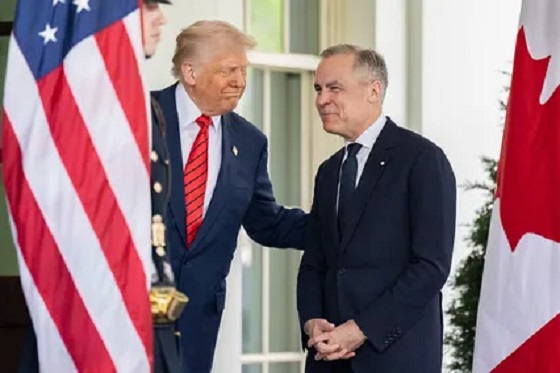Business
Job growth in government exceeded the private sector in 8 out of 10 provinces from 2019-23

From the Fraser Institute
By Ben Eisen and Milagros Palacios
In eight of 10 provinces the rate of government job growth has been higher than the private sector, finds a new study published today by the Fraser Institute, an independent, non-partisan Canadian public policy think-tank.
“Canada’s net job creation in recent years has been disproportionately driven by growth in government employment rather than growth in the private sector, and as of 2019, government employment as a share of total employment in the country is at its highest point since the mid-1990s,” said Ben Eisen, Fraser Institute senior fellow and co-author of Economic Recovery in Canada before and after COVID: Job Growth in the Government and Private Sectors.
The study finds that historically, no other recent era of recession and recovery in Canada have been so dominated by government sector job growth compared to private sector job growth.
During the recession and recovery periods related to the COVID-19 recession (2019-2023), government employment across the country, including federal, provincial and municipal increased by 13.0 per cent compared to just 3.6 per cent in the private sector (including self-employment.)
In every Canadian province save for Alberta and Nova Scotia, employment in the government sector expanded at a higher rate than the private sector. In BC, employment growth in the private sector (including self-employment) rose only by 0.5 per cent during the period compared to 22.0 per cent in the government sector. Ontario’s public sector experienced triple the growth the private sector had, with 14.6 per cent and 4.8 per cent, respectively.
The study also compares the current recession and recovery in Canada to the United States, where the private sector has generated a large majority of all new jobs in recent years. In Canada, the government sector is responsible for 46.7 per cent of total job growth from 2019-203 compared to 16.1 per cent in the United States.
“Canada has seen a much higher rate of job growth in the government sector than the private sector in recent years, which is a concerning trend given that job growth and wealth creation in the private sector are needed to finance the activities of governments,” said Eisen.

- Several past analyses published by the Fraser Institute have shown that in recent years net job creation in the government sector has dramatically outstripped private-sector job creation.
- This publication updates these data, showing that during the recession brought on by the COVID-19 pandemic and the following recovery (2019–2023), government employment has increased by 13.0% while employment in the private sector (including self-employment) increased just 3.6%
- We further expand past analysis by comparing the ongoing recovery from the COVID-19 recession to past periods of economic recession and recovery.
- We find that the extent to which the current economic recovery is driven by government job growth is historically unusual. We compare the current economic environment to five past economic recessions and slowdowns and find that none of those recoveries were nearly as reliant on job creation in the government sector.
- We also compare the current recession and recovery in Canada to that in the United States, which differs sharply. In the United States, the private sector has generated a large majority of all new jobs in recent years and the rate of net job creation in the private sector has been nearly identical to that in the government sector.
- As a result of disproportionately faster growth in the public-sector employment, government’s share of employment post-COVID is higher than at any point since the fiscal consolidations of the 1990s.
Authors:
Business
Trump confirms 35% tariff on Canada, warns more could come

Quick Hit:
President Trump on Thursday confirmed a sweeping new 35% tariff on Canadian imports starting August 1, citing Canada’s failure to curb fentanyl trafficking and retaliatory trade actions.
Key Details:
- In a letter to Canadian Prime Minister Mark Carney, Trump said the new 35% levy is in response to Canada’s “financial retaliation” and its inability to stop fentanyl from reaching the U.S.
- Trump emphasized that Canadian businesses that relocate manufacturing to the U.S. will be exempt and promised expedited approvals for such moves.
- The administration has already notified 23 countries of impending tariffs following the expiration of a 90-day negotiation window under Trump’s “Liberation Day” trade policy.
Diving Deeper:
President Trump escalated his tariff strategy on Thursday, formally announcing a 35% duty on all Canadian imports effective August 1. The move follows what Trump described as a breakdown in trade cooperation and a failure by Canada to address its role in the U.S. fentanyl crisis.
“It is a Great Honor for me to send you this letter in that it demonstrates the strength and commitment of our Trading Relationship,” Trump wrote to Prime Minister Mark Carney. He added that the tariff response comes after Canada “financially retaliated” against the U.S. rather than working to resolve the flow of fentanyl across the northern border.
Trump’s letter made clear the tariff will apply broadly, separate from any existing sector-specific levies, and included a warning that “goods transshipped to evade this higher Tariff will be subject to that higher Tariff.” The president also hinted that further retaliation from Canada could push rates even higher.
However, Trump left the door open for possible revisions. “If Canada works with me to stop the flow of Fentanyl, we will, perhaps, consider an adjustment to this letter,” he said, adding that tariffs “may be modified, upward or downward, depending on our relationship.”
Canadian companies that move operations to the U.S. would be exempt, Trump said, noting his administration “will do everything possible to get approvals quickly, professionally, and routinely — In other words, in a matter of weeks.”
The U.S. traded over $762 billion in goods with Canada in 2024, with a trade deficit of $63.3 billion, a figure Trump called a “major threat” to both the economy and national security.
Speaking with NBC News on Thursday, Trump suggested even broader tariff hikes are coming, floating the idea of a 15% or 20% blanket rate on all imports. “We’re just going to say all of the remaining countries are going to pay,” he told Meet the Press moderator Kristen Welker, adding that “the tariffs have been very well-received” and noting that the stock market had hit new highs that day.
The Canadian announcement is part of a broader global tariff rollout. In recent days, Trump has notified at least 23 countries of new levies and revealed a separate 50% tariff on copper imports.
“Not everybody has to get a letter,” Trump said when asked if other leaders would be formally notified. “You know that. We’re just setting our tariffs.”
Business
Trump slaps Brazil with tariffs over social media censorship

From LifeSiteNews
By Dan Frieth
In his letter dated July 9, 2025, addressed to President Luiz Inácio Lula da Silva, Trump ties new U.S. trade measures directly to Brazilian censorship.
U.S. President Donald Trump has launched a fierce rebuke of Brazil’s moves to silence American-run social media platforms, particularly Rumble and X.
In his letter dated July 9, 2025, addressed to President Luiz Inácio Lula da Silva, Trump ties new U.S. trade measures directly to Brazilian censorship.
He calls attention to “SECRET and UNLAWFUL Censorship Orders to U.S. Social Media platforms,” pointing out that Brazil’s Supreme Court has been “threatening them with Millions of Dollars in Fines and Eviction from the Brazilian Social Media market.”


Trump warns that these actions are “due in part to Brazil’s insidious attacks on Free Elections, and the fundamental Free Speech Rights of Americans,” and states: “starting on August 1, 2025, we will charge Brazil a Tariff of 50% on any and all Brazilian products sent into the United States, separate from all Sectoral Tariffs.” He also adds that “Goods transshipped to evade this 50% Tariff will be subject to that higher Tariff.”
Brazil’s crackdown has targeted Rumble after it refused to comply with orders to block the account of Allan dos Santos, a Brazilian streamer living in the United States.
On February 21, 2025, Justice Alexandre de Moraes ordered Rumble’s suspension for non‑compliance, saying it failed “to comply with court orders.”
Earlier, from August to October 2024, Moraes had similarly ordered a nationwide block on X.
The court directed ISPs to suspend access and imposed fines after the platform refused to designate a legal representative and remove certain accounts.
Elon Musk responded: “Free speech is the bedrock of democracy and an unelected pseudo‑judge in Brazil is destroying it for political purposes.”
By linking censorship actions, particularly those targeting Rumble and X, to U.S. trade policy, Trump’s letter asserts that Brazil’s judiciary has moved into the arena of foreign policy and economic consequences.
The tariffs, he makes clear, are meant, at least in part, as a response to Brazil’s suppression of American free speech.
Trump’s decision to impose tariffs on Brazil for censoring American platforms may also serve as a clear signal to the European Union, which is advancing similar regulatory efforts under the guise of “disinformation” and “online safety.”
With the EU’s Digital Services Act and proposed “hate speech” legislation expanding government authority over content moderation, American companies face mounting pressure to comply with vague and sweeping takedown demands.
By framing censorship as a violation of U.S. free speech rights and linking it to trade consequences, Trump is effectively warning that any foreign attempt to suppress American voices or platforms could trigger similar economic retaliation.
Reprinted with permission from Reclaim The Net.
-

 Bruce Dowbiggin2 days ago
Bruce Dowbiggin2 days agoThe Covid 19 Disaster: When Do We Get The Apologies?
-

 Crime1 day ago
Crime1 day agoSweeping Boston Indictment Points to Vast Chinese Narco-Smuggling and Illegal Alien Labor Plot via Mexican Border
-

 Alberta1 day ago
Alberta1 day agoAlberta school boards required to meet new standards for school library materials with regard to sexual content
-

 Environment1 day ago
Environment1 day agoEPA releases report on chemtrails, climate manipulation
-

 Business15 hours ago
Business15 hours agoTrump slaps Brazil with tariffs over social media censorship
-

 International15 hours ago
International15 hours agoSupport for the Ukraine war continues because no one elected is actually in charge.
-

 Addictions17 hours ago
Addictions17 hours agoCan addiction be predicted—and prevented?
-

 Business18 hours ago
Business18 hours agoCBC six-figure salaries soar





